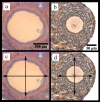Comparative analysis of follicle morphology and oocyte diameter in four mammalian species (mouse, hamster, pig, and human)
- PMID: 16509981
- PMCID: PMC1413548
- DOI: 10.1186/1743-1050-3-2
Comparative analysis of follicle morphology and oocyte diameter in four mammalian species (mouse, hamster, pig, and human)
Abstract
Background: Laboratory animals are commonly used for evaluating the physiological properties of the mammalian ovarian follicle and the enclosed oocyte. The use of different species to determine the morphological relationship between the follicle and oocyte has led to a recognizable pattern of follicular stages, but differences in follicle size, oocyte diameter and granulosa cell proliferation are not consistent across the different species. In an effort to better understand how these differences are expressed across multiple species, this investigation evaluates oocyte and follicle diameters and granulosa cell proliferation in the mouse, hamster, pig, and human.
Methods: Histological sections of ovaries from the mouse, hamster, pig, and human were used to calculate the diameter of the oocyte and follicle and the number of granulosa cells present at pre-determined stages of follicular development. A statistical analysis of these data was performed to determine the relationship of follicular growth and development within and between the species tested.
Results: These data have revealed that the relationships of the features listed are tightly regulated within each species, but they vary between the species studied.
Conclusion: This information may be useful for comparative studies conducted in different animal models and the human.
Figures





Similar articles
-
Species-specific differences in follicular antral sizes result from diffusion-based limitations on the thickness of the granulosa cell layer.Mol Hum Reprod. 2014 Mar;20(3):208-21. doi: 10.1093/molehr/gat078. Epub 2013 Nov 11. Mol Hum Reprod. 2014. PMID: 24217389
-
Populations of granulosa cells in small follicles of the sheep ovary.J Reprod Fertil. 1999 Mar;115(2):251-62. doi: 10.1530/jrf.0.1150251. J Reprod Fertil. 1999. PMID: 10434930
-
Intrafollicular content of luteinizing hormone receptor, alpha-inhibin, and aromatase in relation to follicular growth, estrous cycle stage, and oocyte competence for in vitro maturation in the mare.Biol Reprod. 1999 May;60(5):1120-7. doi: 10.1095/biolreprod60.5.1120. Biol Reprod. 1999. PMID: 10208973
-
Ovarian follicular and luteal physiology.Int Rev Physiol. 1980;22:117-201. Int Rev Physiol. 1980. PMID: 6248477 Review.
-
Control of Oocyte Growth and Development by Intercellular Communication Within the Follicular Niche.Results Probl Cell Differ. 2016;58:191-224. doi: 10.1007/978-3-319-31973-5_8. Results Probl Cell Differ. 2016. PMID: 27300180 Review.
Cited by
-
From primordial germ cells to primordial follicles: a review and visual representation of early ovarian development in mice.J Ovarian Res. 2016 Jun 21;9(1):36. doi: 10.1186/s13048-016-0246-7. J Ovarian Res. 2016. PMID: 27329176 Free PMC article. Review.
-
Influence of ovarian stromal cells on human ovarian follicle growth in a 3D environment.Hum Reprod Open. 2023 Dec 21;2024(1):hoad052. doi: 10.1093/hropen/hoad052. eCollection 2024. Hum Reprod Open. 2023. PMID: 38204939 Free PMC article.
-
Extragonadal oocytes residing in the mouse ovarian hilum contribute to fertility.Biol Reprod. 2017 May 1;96(5):1060-1070. doi: 10.1095/biolreprod.116.145631. Biol Reprod. 2017. PMID: 28339687 Free PMC article.
-
Regulation of Mammalian Oocyte Meiosis by Intercellular Communication Within the Ovarian Follicle.Annu Rev Physiol. 2017 Feb 10;79:237-260. doi: 10.1146/annurev-physiol-022516-034102. Epub 2016 Nov 14. Annu Rev Physiol. 2017. PMID: 27860834 Free PMC article. Review.
-
Three-dimensional in vitro follicle growth: overview of culture models, biomaterials, design parameters and future directions.Reprod Biol Endocrinol. 2010 Oct 14;8:119. doi: 10.1186/1477-7827-8-119. Reprod Biol Endocrinol. 2010. PMID: 20946661 Free PMC article. Review.
References
-
- Hirshfield AN. Development of follicles in the mammalian ovary. Int Rev Cytol. 1991;124:43–101. - PubMed
-
- Peters H. The development of the mouse ovary from birth to maturity. Acta Endocrinol (Copenh) 1969;62:98–116. - PubMed
-
- Pedersen T, Peters H. Proposal for a classification of oocytes and follicles in the mouse ovary. J Reprod Fertil. 1968;17:555–557. - PubMed
LinkOut - more resources
Full Text Sources
